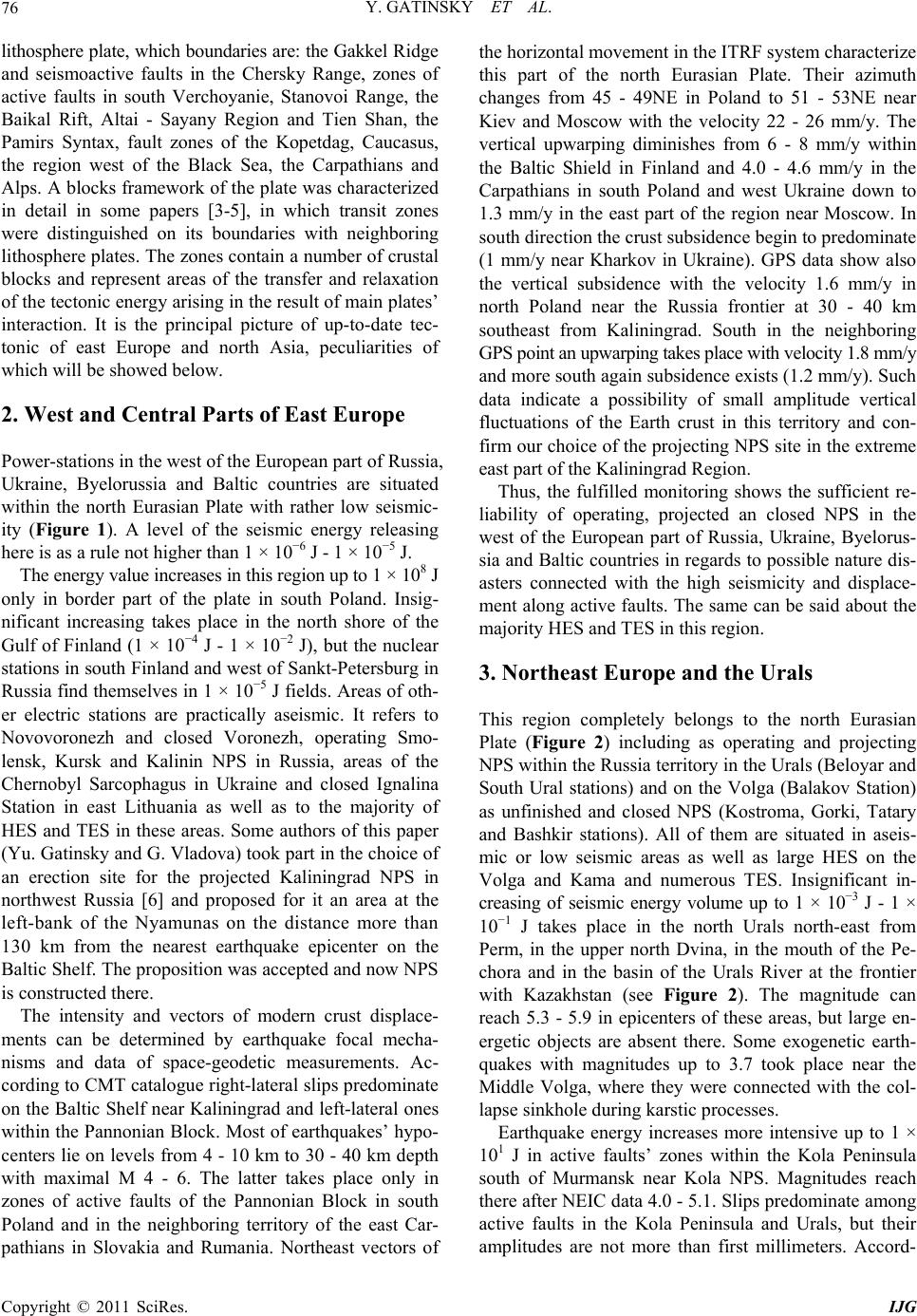
Y. GATINSKY ET AL.
76
lithosphere plate, which boundaries are: the Gakkel Ri dge
and seismoactive faults in the Chersky Range, zones of
active faults in south Verchoyanie, Stanovoi Range, the
Baikal Rift, Altai - Sayany Region and Tien Shan, the
Pamirs Syntax, fault zones of the Kopetdag, Caucasus,
the region west of the Black Sea, the Carpathians and
Alps. A blocks framework of the plate was characterized
in detail in some papers [3-5], in which transit zones
were distinguished on its boundaries with neighboring
lithosphere plates. The zones contain a number of crustal
blocks and represent areas of the transfer and relaxation
of the tectonic energy arising in the result of main plates’
interaction. It is the principal picture of up-to-date tec-
tonic of east Europe and north Asia, peculiarities of
which will be showed below.
2. West and Central Parts of East Europe
Power-stations in the west of the European part of Russia,
Ukraine, Byelorussia and Baltic countries are situated
within the north Eurasian Plate with rather low seismic-
ity (Figure 1). A level of the seismic energy releasing
here is as a rule not higher than 1 × 10−6 J - 1 × 10−5 J.
The energy value increases in this region up to 1 × 108 J
only in border part of the plate in south Poland. Insig-
nificant increasing takes place in the north shore of the
Gulf of Finland (1 × 10−4 J - 1 × 10−2 J), but the nuclear
stations in south Finland and west of Sankt-Petersburg in
Russia find themselves in 1 × 10−5 J fields. Areas of oth-
er electric stations are practically aseismic. It refers to
Novovoronezh and closed Voronezh, operating Smo-
lensk, Kursk and Kalinin NPS in Russia, areas of the
Chernobyl Sarcophagus in Ukraine and closed Ignalina
Station in east Lithuania as well as to the majority of
HES and TES in these areas. Some authors of this paper
(Yu. Gatinsky and G. Vladova) took part in the choice of
an erection site for the projected Kaliningrad NPS in
northwest Russia [6] and proposed for it an area at the
left-bank of the Nyamunas on the distance more than
130 km from the nearest earthquake epicenter on the
Baltic Shelf. The proposition was accepted and now NPS
is constructed there.
The intensity and vectors of modern crust displace-
ments can be determined by earthquake focal mecha-
nisms and data of space-geodetic measurements. Ac-
cording to CMT catalogue right-lateral slips predominate
on the Baltic Shelf near Kaliningrad and left-lateral ones
within the Pannon ian Block. Most of earthquakes’ hypo-
centers lie on levels from 4 - 10 km to 30 - 40 km depth
with maximal M 4 - 6. The latter takes place only in
zones of active faults of the Pannonian Block in south
Poland and in the neighboring territory of the east Car-
pathians in Slovakia and Rumania. Northeast vectors of
the horizontal movement in the ITRF system characterize
this part of the north Eurasian Plate. Their azimuth
changes from 45 - 49NE in Poland to 51 - 53NE near
Kiev and Moscow with the velocity 22 - 26 mm/y. The
vertical upwarping diminishes from 6 - 8 mm/y within
the Baltic Shield in Finland and 4.0 - 4.6 mm/y in the
Carpathians in south Poland and west Ukraine down to
1.3 mm/y in the east part of the region near Moscow. In
south direction the crust subsidence begin to predominate
(1 mm/y near Kharkov in Ukraine). GPS data show also
the vertical subsidence with the velocity 1.6 mm/y in
north Poland near the Russia frontier at 30 - 40 km
southeast from Kaliningrad. South in the neighboring
GPS point an upwarping takes place with velocity 1.8 mm/y
and more south again subsidence exists (1.2 mm/y). Such
data indicate a possibility of small amplitude vertical
fluctuations of the Earth crust in this territory and con-
firm our choice of the projecting NPS site in the extreme
east part of the Kaliningrad Region.
Thus, the fulfilled monitoring shows the sufficient re-
liability of operating, projected an closed NPS in the
west of the European part of Russia, Ukraine, Byelorus-
sia and Baltic countries in regards to possible nature dis-
asters connected with the high seismicity and displace-
ment along active faults. The same can be said about the
majority HES and TES in this region.
3. Northeast Europe and the Urals
This region completely belongs to the north Eurasian
Plate (Figure 2) including as operating and projecting
NPS within the Russia territory in the Urals (Beloyar and
South Ural stations) and on the Volga (Balakov Station)
as unfinished and closed NPS (Kostroma, Gorki, Tatary
and Bashkir stations). All of them are situated in aseis-
mic or low seismic areas as well as large HES on the
Volga and Kama and numerous TES. Insignificant in-
creasing of seismic energy volume up to 1 × 10−3 J - 1 ×
10−1 J takes place in the north Urals north-east from
Perm, in the upper north Dvina, in the mouth of the Pe-
chora and in the basin of the Urals River at the frontier
with Kazakhstan (see Figure 2). The magnitude can
reach 5.3 - 5.9 in epicenters of these areas, but large en-
ergetic objects are absent there. Some exogenetic earth-
quakes with magnitudes up to 3.7 took place near the
Middle Volga, where they were connected with the col-
lapse sinkhole during karstic processe s.
Earthquake energy increases more intensive up to 1 ×
101 J in active faults’ zones within the Kola Peninsula
south of Murmansk near Kola NPS. Magnitudes reach
there after NEIC data 4.0 - 5.1. Slips predominate among
active faults in the Kola Peninsula and Urals, but their
amplitudes are not more than first millimeters. Accord-
Copyright © 2011 SciRes. IJG